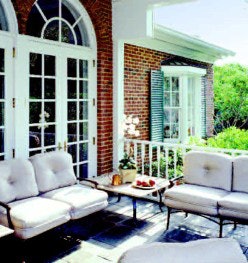
It wasn't that long ago that a sofa on a porch was a sure sign that the neighborhood was heading downhill fast. But today, homes in some of the most upscale neighborhoods are not complete without plushly upholstered pieces adorning their outdoor spaces.
At the intersection of housing trends, lifestyle changes and advanced fabric and finish technologies, you'll find the new casual furniture: big, comfortable, colorful and virtually weatherproof.
Outdoor sectional sofas are perhaps the best example of the current outdoor living style. These modular units translate an already popular family-room style to the exterior of the home, according to Jackie Hirschhaut, vice president of the American Home Furnishings Alliance. And these versatile pieces embody the ongoing trends of entertaining at home, investing in the home resort, creating outdoor living spaces and taking advantage of the latest technology to make furnishings that meet these needs.
Big Is Beautiful
"The scale of the product in the last few years has just continued to get larger. And one of the reasons is that deep seating — club chairs, sofas, settees — is very popular out-of-doors now," says Ken Burrows of Terra Furniture in City of Industry, Calif., and an officer of the board of directors of the Summer & Casual Furniture Manufacturers Association. "The homes are bigger and it calls for heavier-scale merchandise."
Indeed, the size of the American home has increased significantly. According to the National Association of Home Builders, the average American house went from 1,660 square feet in 1973 to 2,400 square feet in 2004. And according to the U.S. Census Bureau, there's been much growth at the upper end of the scale. In 1988 the Census Bureau reported that 11 percent of new single-family houses nationwide were 3,000 square feet or larger. By 2004, 20 percent were 3,000 square feet and over. The Northeast led the size trend with the percentage of new homes over 3,000 square feet growing from 10 percent in 1988 to 25 percent in 2004.
Big houses need big furniture, and that goes for the outside as well as the inside. "It's scale. It's bringing the indoors out," says Burrows. Manufacturers look to interior furniture for a departure point. "So you take your sofas and club chairs that you have in your living room — and they're pretty heavy scale by comparison to what casual furniture used to be."
Just as the haute couture fashion designs from the Paris runways eventually translate down to ready-to-wear styles, so do interior designers help set the trends in home fashions. While the average American family may not use an interior designer, the interior design trade is an important factor in determining the types of pieces that retailers will see at the AQUA Show or the Chicago Merchandise Mart's Casual Furniture Show as they shop for the next season. "An interior designer will say, 'I'm doing this 10,000-square-foot home and I have a huge outside area, and this small stuff gets lost. So we need larger scale.' You get it from the design trade," says Burrows.
Selective Selling
While homes and furniture are getting bigger, retail showrooms generally are not. "Their stores haven't gotten any larger, so they have to be a lot more critical on what they show, because they are showing less merchandise," says Burrows. "They have to be sure of the choices they've made. Right colors, right fabrics, right patterns, the right vendors. It's a lot more complicated today both on the manufacturing as well as the retail side. There's a lot more to choose from and it's easier to make a mistake." Jon Rubinstein, vice president of Robb & Stucky OutdoorLiving, with stores in Florida, Arizona and Texas, agrees. "It forces us to be more creative in the way that we merchandise and display products in the store," he says. "We are changing our vignettes more frequently and also we are making them more store-specific."
Rubinstein says the clientele at each of Robb & Stucky's locations represents a slightly different demographic. "The easiest example is Phoenix versus Naples," he says. "Out in Arizona the trend toward larger furniture is even, well, larger.
"There are some things that are really huge, and what we have to do is figure out which are the key pieces that we want to put in the stores and actually display. Fortunately, with our customer base being at the high end, we do a significant amount of special orders, and that is one of the ways we deal with this trend toward larger furniture."
Additionally, because Robb & Stucky provides design services, many customers work with a designer when they select their furniture. "As a division of a larger company that sells mostly interior furniture, we are wellknown for having interior designers in the store work really closely with customers to do big jobs — maybe the entire house," Rubinstein says. "We kind of take that concept to the outdoors." With a designer as a guide, customers don't have to rely solely on what they see in the showroom. Besides, Rubinstein says, many highend customers would actually prefer something that isn't on the floor.
More Choices
At the same time that there is less space on the show floor, there are more choices than ever before. Hirschhaut says the $2.3 billion-plus wholesale business has more than doubled over the past decade.
"There are some really great high quality all-weather fabrics out there, so there are lots of choices," says Rubinstein.
Perhaps the best-known all-weather fabric brand is Sunbrella, first made by Glen Raven in 1960. Long known for its ability to stand up to the heavyduty demands of marine and awning use, it — and its category — wasn't exactly fashion-forward. But that's changed; Sunbrella and other outdoor textiles are now available in literally hundreds of colors and patterns.
It's a measure of just how far outdoor fabrics have come that design houses one usually associates with expensive silks are now offering their exclusive designs in weather-resistant fabrics. Scalamandre says of its Island Cloth Collection, "The cloth is finished with a drapeable hand to make it possible to curtain cabanas and pool houses, as well as upholster without fear of fading, mildew or chlorine soaked bottoms!" Brunschwig et Fils offers its Tahiti Acrylic Print with a design from the Victoria & Albert Museum, London, collection.
The fabric that makes it all possible is solution-dyed acrylic. Instead of printing colors and patterns onto white or neutral fabrics, color is added to acrylic fibers during manufacturing while they are in a liquid state. The fibers are spun into yarn and then woven into fabrics. This means hours of sun exposure without fading. And because acrylic, if kept clean, won't support the growth of mildew, any customer concerns about maintenance are a thing of the past.
The woven — and therefore breathable — fabrics dry quickly when exposed to moisture. In fact, Glen Raven gives these directions for cleaning its Sunbrella fabrics: "One of the best ways to keep Sunbrella fabrics looking good and to delay the need for deep or vigorous cleaning is to hose fabrics off on a monthly basis with clear water."
Big, beautiful furniture is one more element that's encouraging people to make the most of their living spaces, and to blur the distinction between inside and outside.
Market Mojo
Robb & Stucky is banking on the growing trend toward a seamless indoor-outdoor living space. Its new merchandising concept, Casual Living Outdoor, is a partnership with KitchenAid and includes a fully functional gourmet kitchen with high-end appliances and granite countertops. "The showroom transitions from the kitchen to the family-room concept and then from there to the covered lanai and then finally to the allweather, outdoor pool," says Jon Rubinstein, vice president of Robb & Stucky Outdoor Living.
"There really is a trend towardsmaking it more seamless from the indoors to the outdoors. And it's really all about lifestyle.
"In one store we have a cooking school, called the KitchenAid Culinary Center. And there's a full-time executive chef on staff. It really generates traffic in the demographics that we're targeting — the high-end consumer. You get a lot of similarities in terms of people who are interested in taking high-end cooking classes, and we also do private parties at that location. It really pulls a lot of the people we're trying to target into the store. It generates a lot of sales.
"A lot of the customers we deal with really want more information. And they want to experience it, they don't want to read a brochure. They want to come in and touch it and feel it and smell it. That's really another trend that we're trying to capitalize on. It's a lot of fun and the response has been incredible."
—K.P.









































